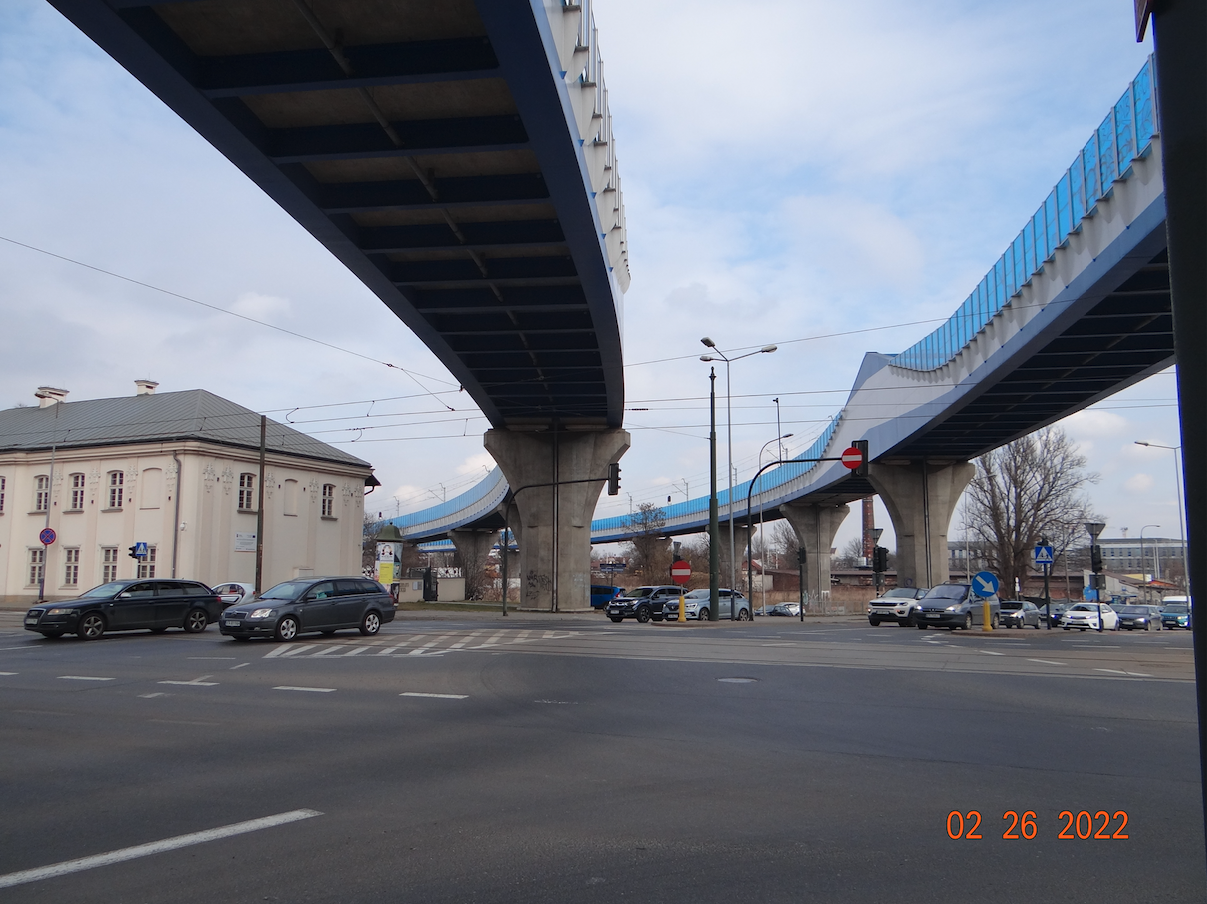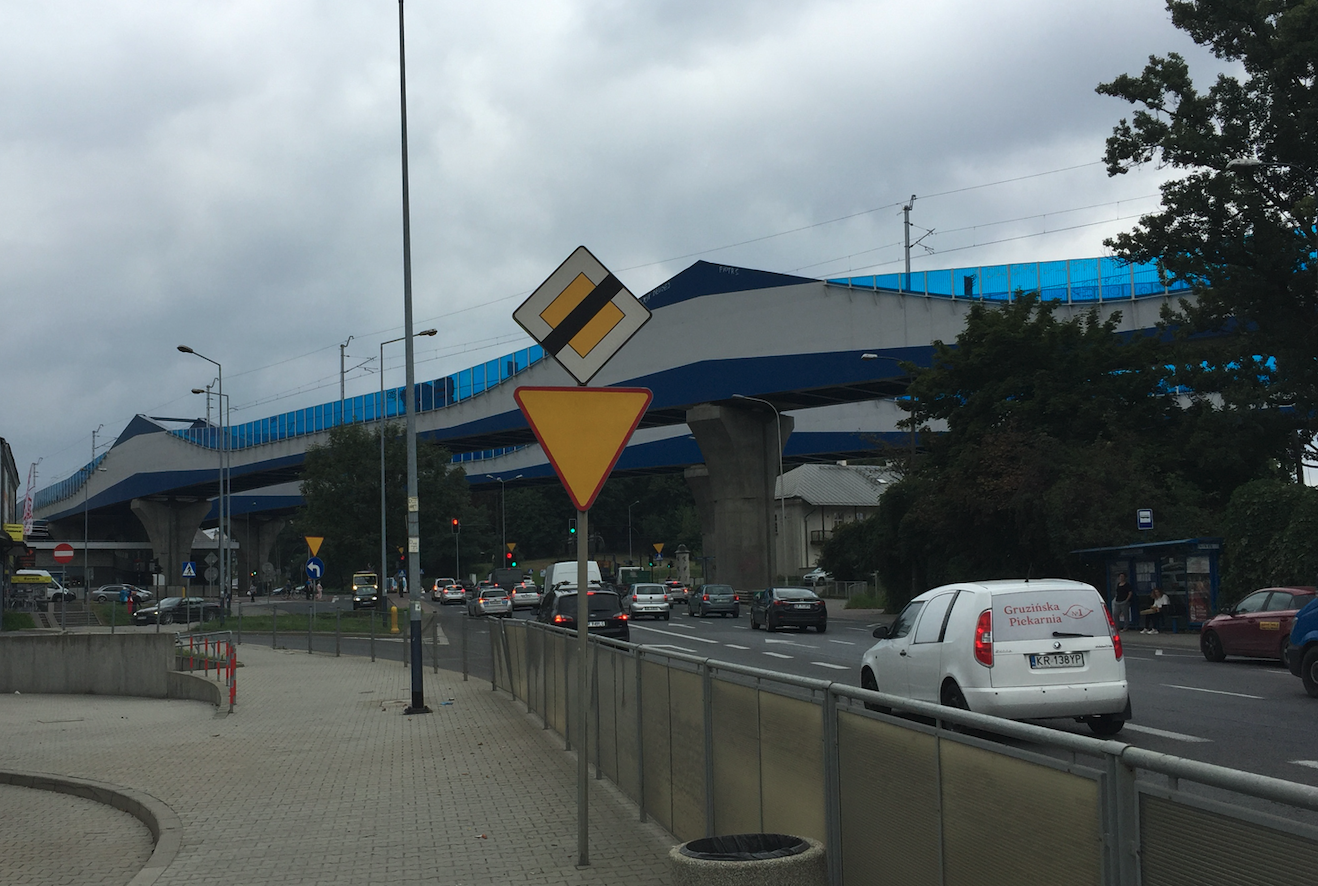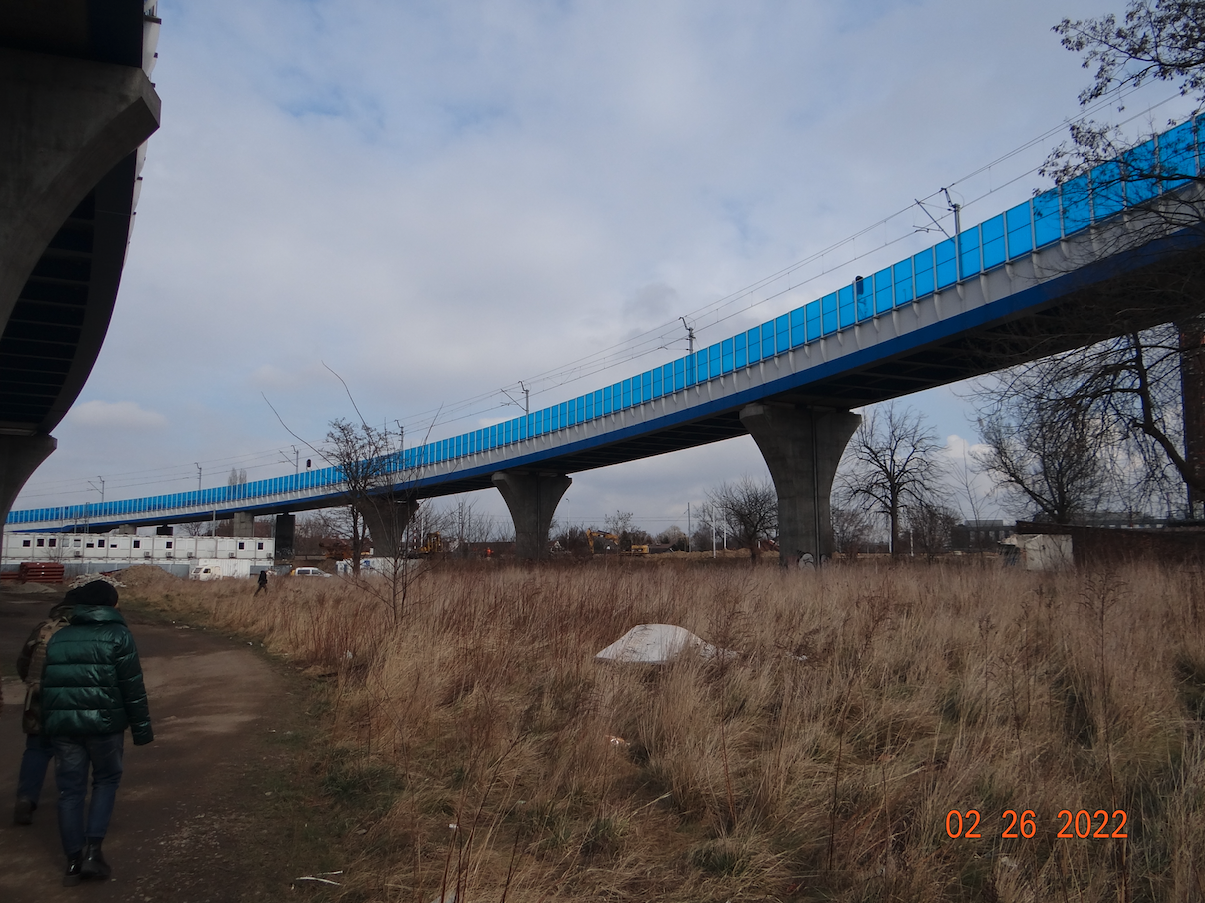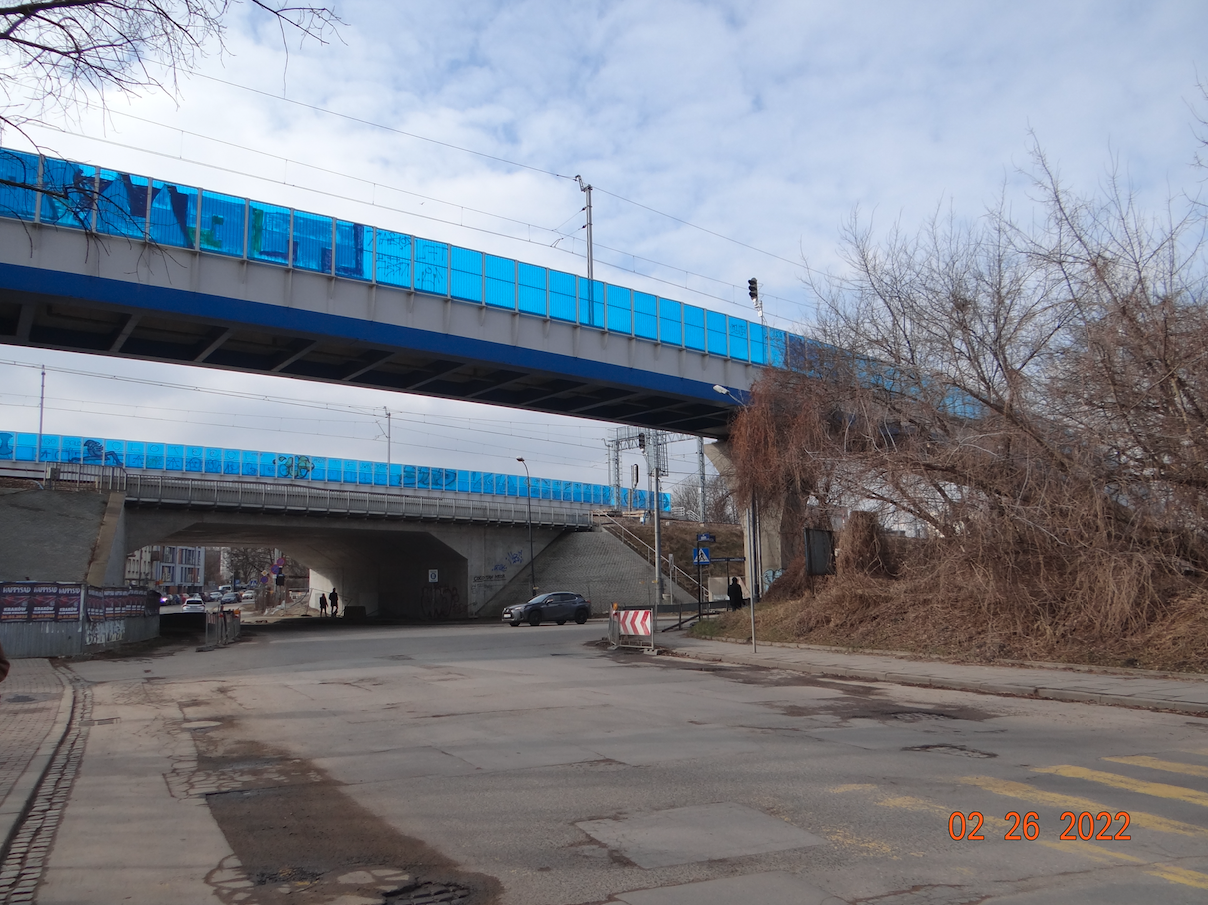Kraków 2022-03-11
PKP Kraków Podgórze.
PKP Railway link No. 624 Kraków Zabłocie - Kraków Bonarka.


Description of the photo: Flyovers over the intersection of the following streets: Wielicka, Bolesława Limanowskiego, Powstańców Wielkopolskich and Aleja Powstańców Ślaskich.
The construction of a railway link has been talked about for many decades. Its necessity was noticed not only by railwaymen, but also by passengers going to Zakopane. The train from Kraków Główny - Zakopane had to change direction three times. For the first time at the Kraków Płaszów station. Second time in Sucha Beskidzka. And the third time in Chabówka. Driving a train by a locomotive extends the journey time considerably. Therefore, the construction of the slip road would have a positive effect on train traffic. Already during the German occupation, there were plans to build such a liaison. But they were not realized. Every few years, the project came back with minor changes, but always, due to a lack of funds, it was not implemented.
It is precisely about the railway connection between the railway line No. 91 (in 1945 No. 124, in 1988 No. 121) and the line No. 94 (in 1945 No. 140, in 1988 No. 135). This liaison was to be located in the vicinity of the Kraków Podgórze railway station. There was even a project of a more extensive link, in which the idea was to keep the train running speed up to 100 km / h. A train going from the Kraków Główny station on line No. 91, after passing the Vistula River, would turn left, to the east, and then in a large curve it would go right in the south-west direction and join the route No. 94. This concept would be implemented either on an embankment with viaducts over road and railroads, or on a flyover. Of course, the cost of such an investment would be much greater.
The chance for the construction of a connector appeared in 2015. The project that was easiest to implement and, at the same time, the least burdensome for the inhabitants of Krakow was selected. The intersection of Wielicka, Bolesława Limanowskiego, Powstańców Wielkopolskich and Aleja Powstańców Ślaskich, which is important in Krakow, has never been completely blocked for traffic.
The link became the No. 624 Kraków Zabłocie - Kraków Bonarka railway line, 3.161 km long, double-track, electrified (3 kV), with a maximum train speed of 60 km / h.
The contract for the construction of the liaison was signed on September 16, 2015, and on December 10, 2017, regular train traffic began there. The value of the liaison is PLN 258 million, and all additional tasks total PLN 348 million. Co-financing from the EU amounts to PLN 187 million.
The connector road starts at the Kraków Zabłocie passenger stop, on the right bank of the Vistula, on the line No. 91 Kraków Główny - Medyka. One lane goes to the left and the other (back) to the right. Both tracks enter individual flyovers. The flyovers pass over Jana Dekerta Street and head south-west in an arch. The flyovers pass centrally over the intersection of Wielicka, Bolesława Limanowskiego, Powstańców Wielkopolskich and Aleja Powstańców Ślaskich streets. After the intersection, Platform 1 of the Kraków Podgórze station begins. Further, without railroad junctions, the route runs to the Kraków Bonarka station and here it joins the route No. 94.
The investment, along with the complete reconstruction of the Kraków Płaszów railway station, was carried out by a consortium of Budimex and Ferrovial Agroman. The railway works were performed by the KZN Rail company. The Kraków Zabłocie station, which was previously modernized in 2014, was also expanded.
In September 2015, the Kraków Zabłocie passenger stop was put out of service, and then one platform edge was re-opened for SKM agglomeration trains. The Kraków Krzemionki (Podgórze) stop was closed to passenger traffic in March 2016. Let us remember that at that time, the railway route from the Kraków Zabłocie station to the Kraków Główny station was being renovated. Only one track was open. A new bridge was built over the Vistula River and a flyover near Grzegórzecka Street. For this reason, many long-distance trains ran from / to Kraków Główny, from the east, taking a detour through Batowice and Nowa Huta stations.
Within a few months, all the reinforced concrete supports (pillars) for the new flyovers were built. 30 pillars were built. The highest pillar is 14.5 m high. The distances between the pillars are from 31 to 81 m. Since June 2016, the assembly of steel spans of the flyovers, consisting of 28 elements, has started. The spans have a steel plate girder structure, where the main forces are transferred on the side structures. Thanks to this, and thanks to the installation of sound barriers, the passing train does not have a negative impact on the increase of the noise level. Passing cars make much more noise.
The railway flyover in Kraków is the largest such facility in Poland, with a total length of 1 153 m. It consists of two flyovers supported by 30 pillars. The eastern flyover is 612 m long, and the western flyover is 541 m long. As part of the investment, 9,000 m of tracks and 6 railway turnouts were also reconstructed. Each pillar is nearly 400 tons of concrete, and the longest span is 200 tons. 7,000 tons of structural steel, over 3,000 tons of reinforcing steel and 25,500 tons of concrete were used to build the link.
Track No. 1, the west track has a curve radius of 258 m, and track No. 2, the east track has a curve radius of 275 m. The rails are laid on metal "Y" sleepers. The first reason for using these sleepers was the small radius of the bends. The second; Y-type sleepers are much quieter when a train passes over them.
In December 2016, the structures of the flyovers were ready. In August 2017, the tracks were ready. Also in August 2017, the Kraków Podgórze station was ready. On December 7, 2017, the liaison was officially opened. On December 9, 2017, the first scheduled train, TLK "Uznam", traveled to Zakopane along with the new timetable.
The positive effect of building the link appeared very quickly. Trains from Kraków Główny - Skawina shortened the travel time from 40 - 45 minutes to 25 - 30 minutes.
In March 2018, due to other railway works, the traffic on the slip road No. 624 was limited to the track No. 2 (eastern). The maximum speed of the train running on the flyover is a maximum of 60 km / h. This is also the reason for reducing the nuisance of passing trains.
In 2018, the liaison was awarded the title of the "Bridge Work of the Year 2017" by the Union of Bridge Builders of the Republic of Poland. Nevertheless, there are many malcontents who do not like the wharf, especially its colors. We do not share these views. This strong blue color is intended to warn birds not to fall into an obstacle.

Description of the photo: The eastern flyover is visible in the center.

Description of the photo: Dekerta Street. Behind the viaduct, there is Kącik Street. In the foreground, the eastern flyover. On the viaduct, the line No. 91 and the western flyover.
Current state. 2022.
Currently (2022), the construction of a new railway bridge over the Vistula River is underway. Virtually three modern parallel bridges are built. The goal is to fit four new railway tracks on the cross-city line. To date, there have only been two tracks. The bridge on the east side is ready and put into operation in 2020. There is one track on it. After the construction of the first bridge, the demolition of the old double-track bridge was started, which was set on five supports, three of which had foundations at the bottom of the river. The new middle bridge is well under construction and, like the third, west bridge, is expected to be ready by December 2022. This bridge is to have two tracks. The third bridge is to have one track and a pedestrian and bicycle pavement.
Currently (2022), the extension of the Kraków Zabłocie railway station is underway. Only one track is open. The station will still have two platforms for servicing agglomeration trains. Two additional tracks will be used by long-distance trains that will not stop here. The length of the platforms is 200 m. The station is built on a widened embankment. The station was already adapted to service the disabled and that will be maintained.
In the past, the Zabłocie passenger stop had only two single-edge platforms, without benches and roofing, and usually concrete stairs for descending from the platform and the embankment. The stop was used mainly by employees of workplaces located in Zabłocie. There was a pedestrian tunnel in the embankment, connecting Kącik Street with Lipowa Street.
Behind the Zabłocie station, there is a railway turnout system for diverting trains either to the Kraków Płaszów station or to the flyover to the Kraków Bonarka station via Kraków Podgórze. Currently (2022) only the eastern flyover is open. The Kraków Podgórze station is 100% completed. Passenger traffic is low due to other railway works. The track section Kraków Podgórze - Kraków Bonarka is completely renovated.
Written by Karol Placha Hetman
